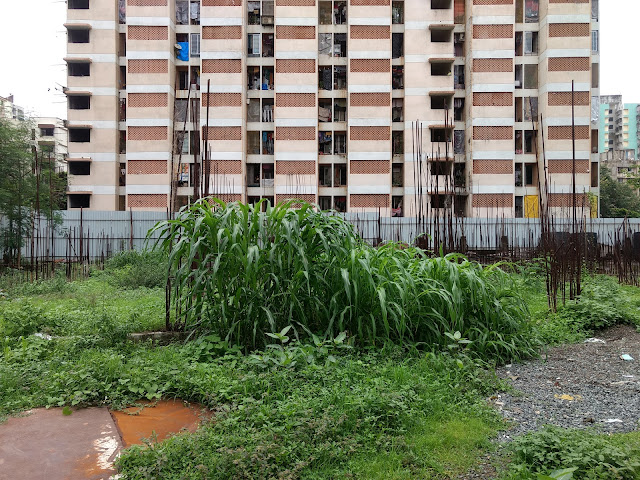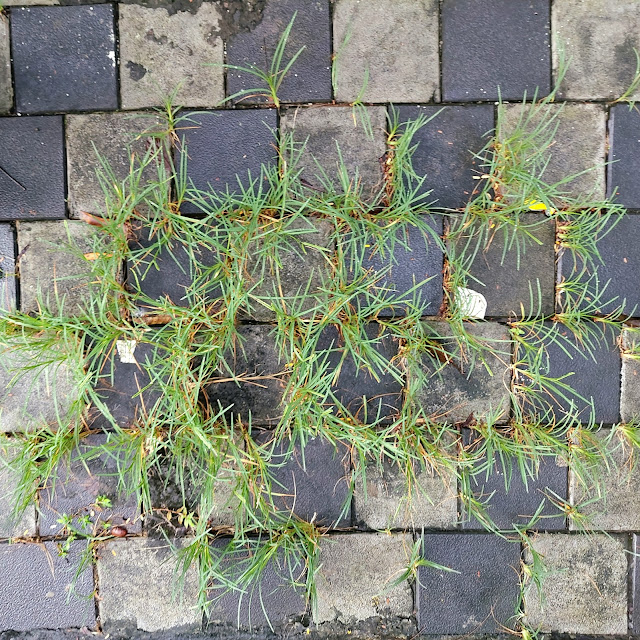My first coordinate comes from my interaction with architect Rahul Gore (_Opolis) whose undergraduate architecture research thesis at CEPT looked closely at the practice of Nari Gandhi. As many might know, Nari Gandhi had the opportunity of working with Frank Lloyd Wright, and the idea of organic architecture was deeply engrained in his work. Gandhi worked closely with the site conditions integrating his built form within its environmental settings. Nari Gandhi hardly made any drawings for his projects, and responded intimately and instinctively to the conditions of his sites. Gore's thesis documents four of his projects in detail studying the relationship between architecture and nature embedded in Gandhi's works. In explaining one of his house-sections, Rahul explained how Gandhi's buildings did not differentiate between architecture and nature, rather imagined them as a continuum. The building nestled between the trees would attract birds that would feed on the fruits, and their droppings would be eventually collected onto the terracotta-tiled roof crevices. These crevices would collect dust and dry leaves that would layer these bird droppings that would contain undigested seeds, nurtured often by the digestive enzymes as well as protected by the eventual natural decay of plant matter. By the monsoon, these crevices of the roof containing seedlings would erupt into plants to the rainwater and grow into gentle plants that created a green cover over the entire building. Given Nari Gandhi's pavilion-type buildings in the environment, these monsoonal plants didnot harm the structure, rather they became a part of them. The micro gardens emerging within the corners of the city index processes that enable the optimal conditions and scale for plants to exist alongside everything else in the city. While in some cases they may be fatal, these instances could be harnessed to imagine low maintenance micro green corners within our urban environment.
I recall one such instance of the High Line in Manhattan, New York where the landscape architect James Corner decided to work with the wild outgrowth of weeds on overlooked elevated railway track rather than sweeping the site away to contain a manicured garden. Here, Corner reorients the user to appreciate the natural coexistence of weeds and railway-tracks, of wilderness and industry as the appropriate landscape to inhabit. The weeds speak of wasteland, ruin, neglect while taking over the unused tracks, already suggesting its conversion into a garden, preparing it for a new user. The weeds then, must be the image of the landscape. These associations challenge our aesthetic register of consuming heavily manicured gardens in urban settings. This is not to say that the landscape on the High Line is not curated - infact a huge amount of money now goes into preserving and reinstating the gardens on the elevated track ever year, after the winter. However, the gesture to embrace the outgrowth of weeds into the urban landscape is a powerful one. In cases here, I have observed how weeds growing in unattended construction sites for a long time begin to camouflage with the reinforcement bars - begin to tell the story of waithood. Yet, when the wait is over, such a lovely dialogue of eruptions - of both - the bars and the weeds, is lost to the decorative plantations that must only fit the frame of beautification in the discourse of conventional landscape - those that must be maintained by unimaginative gardeners who are employed by these built enterprises.
In the spree of greening and beautification, a huge amount of funds are being spent to first clarify rough edges of urban intersections between infrastructure and nature, and new containments are created to plant absolutely alien species of plants. Natural greens require regular maintenance and are a cost to the authorities, and therefore, several landscape architects choose foreign hardly plants which can exist even in less water or attention. In cases where urban authorities do not have access or funds to hire landscape architects, they take rather drastic decisions to offer lip-service to the cause of greening. A popular one was to literally paint walls and vertical surfaces in green colour. More recently, one of the politicians got a wall embanking a natural mountain onto the national highway - covered in plastic green. This wall once used to find its own way of greening itself during the monsoon, rather generously and elegantly. With the flattened roughness of the stony cliff using a concrete retaining wall, the scope for natural processes has been lost. Rather, a plastic idea of the green is now celebrated that shall remain green forever.
Alien species of trees planted within malls and five star hotels are deemed by landscape architects as "beautiful", however, these do not hold any meaning to us beyond a mere image, as well as are divorced from the processes of the environment within our context. The self growth of small plants in our left over landscapes perhaps hold some clues in how landscape wants itself to be imagined within our context. In gently sprouting from the corners and gaps of unfinished architectures, they bring grace to the otherwise errors of unskilled building craftsmanship. In other instances, they become benign microcosms that come and go with seasons, perhaps allowing essential insects and microbes to maintain the continuities of our ecosystems. But more important than anything else, these auto-landscapes beg us to consider the flora and fauna that must exist here, that perhaps belong here, that can exist optimally here. Perhaps, there is only a little to tame, rather than erase them all and not allow it to happen altogether? Some years ago when we had visited the hamlets within the core inner area of the Sanjay Gandhi National Park in Mumbai, a young boy who grew up in the forest walked us through, telling us the name of each and every plant that organically grew along our walkway. Occasionally plucking leaves, rubbing ferns, picking berries, pulling shoots - he animated the forest in his intimate familiarity of his landscape. Do we know the names of plants that grow in the sliver gardens of our building compounds maintained by some contractual gardener? Are we cognizant of what trees grow around us and what trees want to grow around us?
It is in this vein that I collect these photographs here. Last monsoon, Dushyant and I picked up a slice of moss growing in the cracks of the concrete mortar on our institute's boundary wall to nurture a herbarium. Enclosing it in a tiny transparent bottle, we hoped to nurture it by the window of our workspace. But just before doing so, we took our respective mobile phones to take pictures of these natural growths through the macro feature on our respective mobile cameras. What we discovered was quite amazing. A whole micro forest - perhaps - slowly beginning to expand and emerge. And perhaps it cannot, but will become useful as manure for the larger trees that shelter them! While the experiment did not fructify to our expectation, we wait for the next monsoon to re-cover our campus landscape. In the meantime we move through our intermittent gardens dispersed across the school occasionally to talk to plants, appreciate their formations and listen into the stories they hold within them.

















































